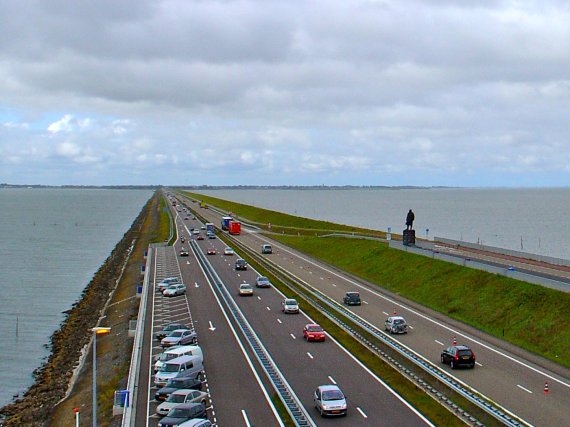The aim of the power station is to ‘demonstrate that the technology works on a real scale with real water, right in the middle of the Afsluitdijk,’ Cees Buisman explains in an email. This professor of Environmental Technology and scientific director of Wetsus has been working on the plan since 2004. He is a firm supporter of the technique which is ‘CO2 neutral, absolutely clean and part of a closed cycle.’ Other advantages, he adds, are low costs and weather-independence. The plan to generate energy at the confluence of sea water and fresh water dates back to the 1970’s. The idea is simple: Salt water has many more ions (charged chlorine and sodium atoms). This water can be channelled into adjacent chambers separated by a membrane which lets ions through which are either positive or negative. The resulting tension can be harnessed to produce electricity. The power station will have a capacity of 50 kilowatts, similar to that of ‘a small windmill’. It will be built by a consortium which counts among its members the water institute Wetsus, in which Wageningen participates. Companies taking part include Fuji, Alliander and Redstack. Eight million euros have been set aside for the construction. The power station forms part of a bigger plan to make the Afsluitdijk ready for the future. This plan includes a round of renovations, more water drainage capacity from the IJssel Lake and production of sustainable energy. Applying blue energy may also have positive effects on nature. The mixing of water results in brackish water which often is home to unique species. Although blue energy has a lot of potential, it is still wrought with question marks. In a 2010 report, the Dutch Energy Research Centre (ECN) placed the potential of the Afsluitdijk at 200 megawatts. In theory, it can generate more than enough electricity for 450,000 households. However, ECN does not expect this capacity to be reached before 2030. Buisman thinks that the question marks can be removed ‘within several years’. He also does not foresee problems with the availability of funds as construction can be carried out in modules of 200 kilowatts.
Funds ready for blue energy test station
It's been confirmed: a blue energy experimental station will be built on the Afsluitdijk - the causeway which separates the IJssel Lake from the sea. Blue energy can be generated when sea water comes into contact with fresh water. It looks like the long cherished wish of Wageningen UR professor Cees Buisman will finally be…

